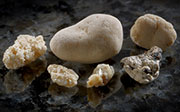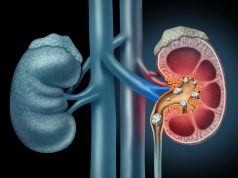Difference in outcomes due to patients with proximal and mid ureteral, not distal, stones
THURSDAY, July 16, 2015 (HealthDay News) — For ureteral stones, extracorporeal shock wave lithotripsy delivered at a shock wave delivery rate of 90 pulses per minute is associated with excellent outcomes, according to a study published in the August issue of The Journal of Urology.
Daniel P. Nguyen, M.D., from the University of Bern in Switzerland, and colleagues compared the outcomes of two delivery rates in a prospective randomized trial involving 254 consecutive patients with solitary ureteral stones. Participants were randomized to receive extracorporeal shock wave lithotripsy at a shock wave delivery rate of 60 and 90 pulses per minute (130 and 124 participants, respectively).
The researchers found that at three months, the stone-free rate was significantly higher in patients who underwent extracorporeal shock wave lithotripsy at a shock wave delivery rate of 90 pulses versus 60 pulses per minute (91 versus 80 percent; P = 0.01). The observed difference was due to patients with proximal (100 versus 83 percent; P = 0.005) and mid ureteral (96 versus 73 percent, respectively; P = 0.03) stones, but not those with distal ureteral stones (81 versus 80 percent; P = 0.9). Independent predictors of success included shock wave delivery rate of 90 pulses per minute, proximal stone location, stone density, stone size, and an absent indwelling Double-J stent, on multivariable analysis.
“Optimizing the extracorporeal shock wave lithotripsy delivery rate can achieve excellent results for ureteral stones,” the authors write.
Copyright © 2015 HealthDay. All rights reserved.








